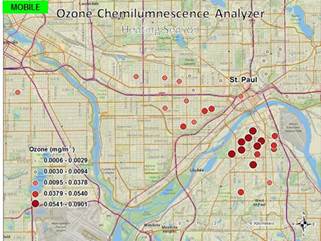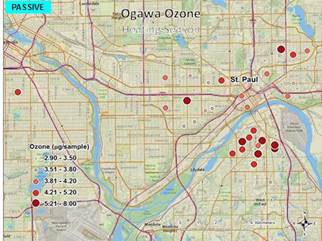Grantee Research Project Results
2012 Progress Report: Exposure Mapping – Characterization of Gases and Particles for ExposureAssessment in Health Effects and Laboratory Studies
EPA Grant Number: R834796C001Subproject: this is subproject number 001 , established and managed by the Center Director under grant R834796
(EPA does not fund or establish subprojects; EPA awards and manages the overall grant for this center).
Center: University of Washington Center for Clean Air Research
Center Director: Vedal, Sverre
Title: Exposure Mapping – Characterization of Gases and Particles for ExposureAssessment in Health Effects and Laboratory Studies
Investigators: Yost, Michael , Larson, Timothy V. , VanReken, Timothy M. , Simpson, Chris , Jobson, B. Thomas
Current Investigators: Yost, Michael , VanReken, Timothy M. , Jobson, B. Thomas , Larson, Timothy V. , Simpson, Chris
Institution: University of Washington , Washington University
EPA Project Officer: Callan, Richard
Project Period: December 1, 2010 through November 30, 2015 (Extended to November 30, 2017)
Project Period Covered by this Report: December 1, 2011 through November 30,2012
RFA: Clean Air Research Centers (2009) RFA Text | Recipients Lists
Research Category: Air Quality and Air Toxics , Air
Objective:
- Characterize spatial and temporal gradients of selected air pollutants along roadways and within neighborhoods in MESA cities using a mobile platform.
- Measure spatial variation in concentrations of selected air pollutants at 2-week average stationary sites in coordination with the mobile measurements.
- Characterize aging of air pollutant components as they are transported from roadway sources to neighborhood receptor locations.
- Provide detailed characterization of laboratory exposure conditions available for toxicology testing, and identify likely conditions that mimic those found in urban settings.
Progress Summary:
Aims 1 and 2 continue as the main focus of activities in this year 2 time period. This phase of the study is conducting field sampling through 2013 across four cities in the MESA-Air cohort: Minneapolis/St. Paul, MN; Baltimore, MD; Los Angeles, CA; and Winston-Salem, NC. The instrument platform for mobile monitoring was assembled and tested in Seattle in October of 2011. Heating season measurements have been completed in Minneapolis/St. Paul and Baltimore; non-heating season measurements are completed in Baltimore and are under way in St. Paul. During each 2-week sampling period, the mobile monitoring platform measures concentrations of particles and gases while continuously on the move along a fixed sampling route with position information simultaneously logged by a real-time GPS. Data collection includes the following components: optical particle size in 31 size bins from 10 to 0.2 μm, particle mean diameter and particle count from 0.03 to 0.2 μm, total particle count >0.1 μm, particle light scattering coefficient, particle light absorption (black carbon), NO/NO2, O3, CO, CO2 and total VOCs.


Future Activities:
Journal Articles:
No journal articles submitted with this report: View all 43 publications for this subprojectSupplemental Keywords:
exposure science, community exposures, chemical transport, mobile monitoring, Health, Air, Scientific Discipline, ENVIRONMENTAL MANAGEMENT, Health Risk Assessment, Risk Assessments, Air Quality, mobile sources, Atmospheric Sciences, Biochemistry, air toxics, Environmental Monitoring, Risk Assessment, aerosol particles, vehicle emissions, bioavailability, atmospheric chemistry, motor vehicle emissions, particulate matter, motor vehicle exhaust, ambient particle health effects, cardiotoxicity, air quality models, air pollutants, atmospheric aerosols, atmospheric particulate matter, vascular dysfunction, ambient air quality, air pollution, cardiovascular disease, exposure assessment, airway diseaseProgress and Final Reports:
Original AbstractMain Center Abstract and Reports:
R834796 University of Washington Center for Clean Air Research Subprojects under this Center: (EPA does not fund or establish subprojects; EPA awards and manages the overall grant for this center).
R834796C001 Exposure Mapping – Characterization of Gases and Particles for ExposureAssessment in Health Effects and Laboratory Studies
R834796C002 Simulated Roadway Exposure Atmospheres for Laboratory Animal and Human Studies
R834796C003 Cardiovascular Consequences of Immune Modification by Traffic-Related Emissions
R834796C004 Vascular Response to Traffic-Derived Inhalation in Humans
R834796C005 Effects of Long-Term Exposure to Traffic-Derived Particles and Gases on Subclinical Measures of Cardiovascular Disease in a Multi-Ethnic Cohort
The perspectives, information and conclusions conveyed in research project abstracts, progress reports, final reports, journal abstracts and journal publications convey the viewpoints of the principal investigator and may not represent the views and policies of ORD and EPA. Conclusions drawn by the principal investigators have not been reviewed by the Agency.
Project Research Results
- Final Report
- 2016 Progress Report
- 2015 Progress Report
- 2014
- 2013 Progress Report
- 2011 Progress Report
- Original Abstract
18 journal articles for this subproject
Main Center: R834796
197 publications for this center
93 journal articles for this center
